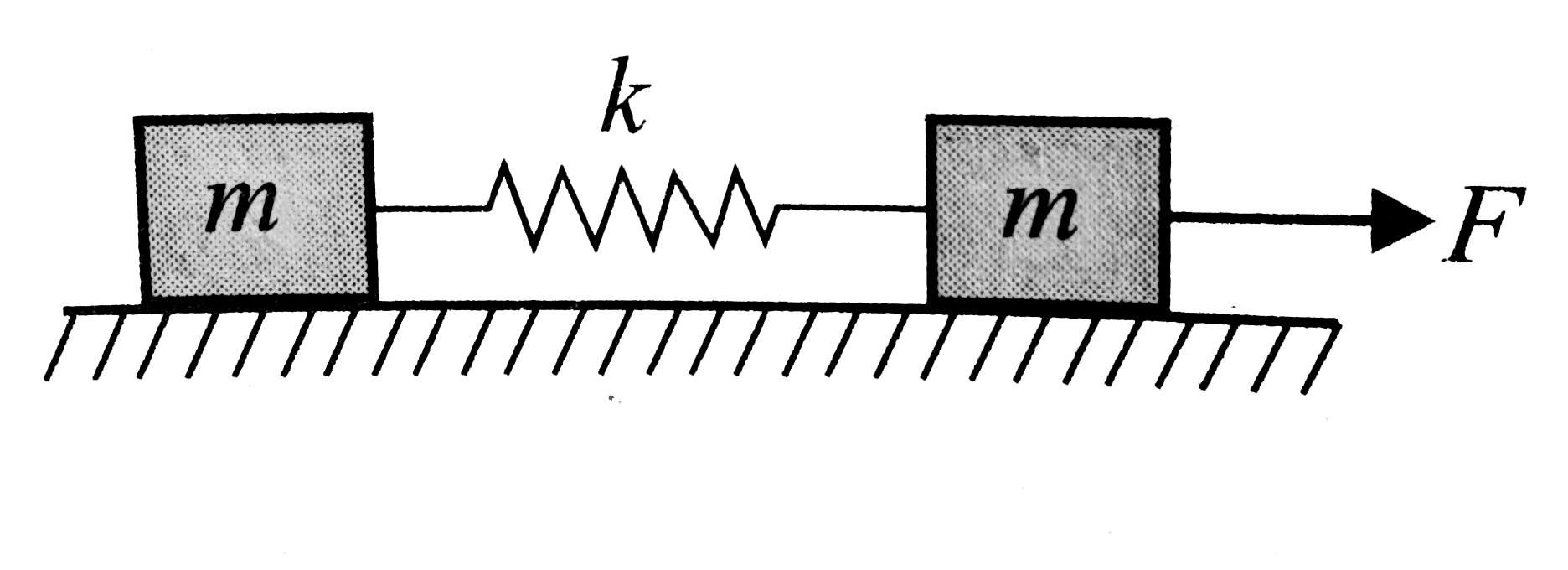Two blocks of masses and are connected with a light spring of force constant k and the whole system is kept on a frictionless horizontal surface. The masses are applied forces and as shown in fig. At any time the blocks have same acceleration but in opposite direction. Now answer the following :

the value of spring force is
The correct Answer is:D
In horizontal direction, both and will have same acceleration for any case. In vertical direction also, they should have same acceleration. Let it be a upwards for boths, then
..(i)
…(ii)
From (i) and (ii) , .
Topper's Solved these Questions
- NEWTON'S LAWS OF MOTION 1Book:CENGAGE PHYSICSChapter:NEWTON'S LAWS OF MOTION 1Exercise:Integer
Explore 5 Videos
- NEWTON'S LAWS OF MOTION 1Book:CENGAGE PHYSICSChapter:NEWTON'S LAWS OF MOTION 1Exercise:Assertion-reasoning
Explore 15 Videos
- MISCELLANEOUS VOLUME 2Book:CENGAGE PHYSICSChapter:MISCELLANEOUS VOLUME 2Exercise:INTEGER_TYPE
Explore 10 Videos
- NEWTON'S LAWS OF MOTION 2Book:CENGAGE PHYSICSChapter:NEWTON'S LAWS OF MOTION 2Exercise:Integer type
Explore 1 Video
Similar Questions
Two blocks of masses m1andm2 being connected with a light spring of stiffness k are driven with forces F1andF2 on a smooth horizontal plane.

View SolutionTwo blocks of masses m and m' are connected by a light spring on a horizontal frictionless table . The spring is compressed and then released . Find the ratio of acceleration of masses .
View Solution
Knowledge Check
Two blocks of masses m1 and m2 are connected with a light spring of force constant k and the whole system is kept on a frictionless horizontal surface. The masses are applied forces F1 and F2 as shown in fig. At any time the blocks have same acceleration a0 but in opposite direction. Now answer the following :

The value of a0 isAF1−F2m1+m2BF1−F2m1−m2CF1+F2m1−m2DF1+F2m1+m2Two blocks of masses m1 and m2 are connected with a light spring of force constant k and the whole system is kept on a frictionless horizontal surface. The masses are applied forces F1 and F2 as shown in fig. At any time the blocks have same acceleration a0 but in opposite direction. Now answer the following :

If F2 is removed at this moment, then just after the acceleration of m2 isAF1m2Ba0+F1m2CF2m2−a0Da0+F2m2Two blocks of masses m1 and m2 are connected by an ideal sprit, of force constant k. The blocks are placed on smooth horizontal surface. A horizontal force F acts on the block m1. Initially spring is relaxed, both the blocks are at rest.

What is maximum elongation of spring.A2m1F(m1+m2)kBm21F2(m1+m2)kC2m2Fk(m1+m2)Dm22F2(m1+m2)2k
Two blocks of mass m1andm2 are connected by a spring of force constant k. Block of mass m1 os pulled by a constant force f2 [see fig 4E.19 (a)] find the maximum elongation in the spring .

View SolutionTwo blocks of masses m1 and m2 are connected by a spring of stiffness k. The coefficient of friction between the blocks and the surface is μ. Find the minimum constant force F to be applied to m1 in order to just slide the mass m2.

View SolutionTwo blocks of masses m1 and m2 are connected by an ideal sprit, of force constant k. The blocks are placed on smooth horizontal surface. A horizontal force F acts on the block m1. Initially spring is relaxed, both the blocks are at rest.

What is acceleration of centre of mass of system at the instant of maximum elongation of spring
View SolutionTwo blocks of masses m1 and m2 are connected by an ideal sprit, of force constant k. The blocks are placed on smooth horizontal surface. A horizontal force F acts on the block m1. Initially spring is relaxed, both the blocks are at rest.

Which of the following statement is not true tn the watt of above system.
View SolutionTwo blocks of equal mass m are connected by an unstretched spring and the system is kept at rest on a frictionless horizontal surface. A constant force F is applied on the first block pulling away from the other as shown in Fig.

Then the displacement of the centre of mass in at time t is
View Solution
